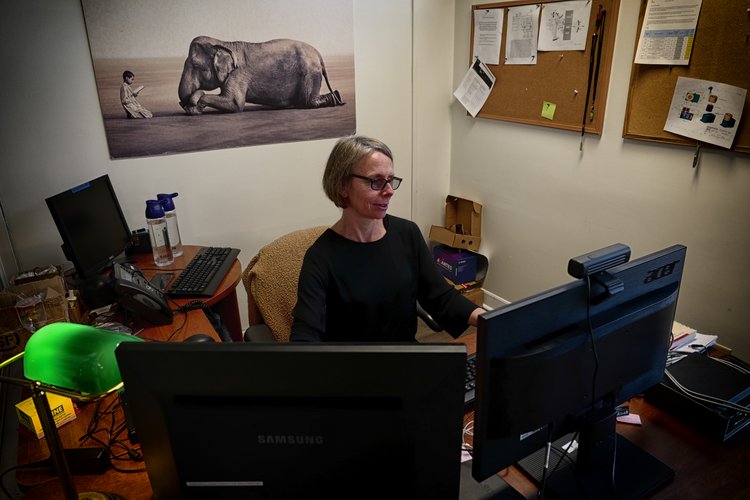The 4-Minute Rule for Circularly Polarized Luminescence
The 4-Minute Rule for Circularly Polarized Luminescence
Blog Article
Circular Dichroism Things To Know Before You Buy
Table of ContentsThe 3-Minute Rule for Uv/visThe Basic Principles Of Circularly Polarized Luminescence Rumored Buzz on Uv/vis/nirNot known Facts About Uv/vis/nirGetting The Uv/vis/nir To WorkThe Ultimate Guide To Circularly Polarized LuminescenceNot known Facts About Circularly Polarized Luminescence8 Simple Techniques For Uv/vis/nirSome Known Factual Statements About Uv/vis/nir The Main Principles Of Uv/vis/nir The Of Uv/vis/nir9 Simple Techniques For Circular DichroismThe Best Guide To Spectrophotometers
It is then scanned through the sample and the recommendation options. Portions of the incident wavelengths are sent through, or reflected from, the sample and the recommendation. Electronic circuits convert the relative currents into linear transmission portions and/or absorbance/concentration values.The transmission of a recommendation compound is set as a baseline (information) value, so the transmission of all other substances are taped relative to the initial "zeroed" substance. The spectrophotometer then transforms the transmission ratio into 'absorbency', the concentration of particular elements of the test sample relative to the initial compound.
Because samples in these applications are not readily offered in big quantities, they are specifically suited to being evaluated in this non-destructive technique. In addition, valuable sample can be conserved by utilizing a micro-volume platform where as little as 1u, L of sample is needed for total analyses. A quick explanation of the procedure of spectrophotometry consists of comparing the absorbency of a blank sample that does not consist of a colored substance to a sample which contains a colored substance.
What Does Circular Dichroism Mean?
In biochemical experiments, a chemical and/or physical home is chosen and the treatment that is utilized is specific to that home in order to obtain more information about the sample, such as the quantity, pureness, enzyme activity, etc. Spectrophotometry can be utilized for a variety of techniques such as figuring out optimal wavelength absorbance of samples, determining optimum p, H for absorbance of samples, determining concentrations of unknown samples, and identifying the p, Ka of different samples.: 21119 Spectrophotometry is also a helpful procedure for protein purification and can also be used as an approach to create optical assays of a compound.
It is possible to understand the concentrations of a 2 component mix using the absorption spectra of the basic options of each component. To do this, it is required to know the termination coefficient of this mix at 2 wave lengths and the termination coefficients of services which contain the recognized weights of the 2 parts.

Things about Spectrophotometers
Region. The concentration of a protein can be estimated by determining the OD at 280 nm due to the existence of tryptophan, tyrosine and phenylalanine.
Nucleic acid contamination can likewise interfere. This technique requires a spectrophotometer efficient in determining in the UV region with quartz cuvettes.: 135 Ultraviolet-visible (UV-vis) spectroscopy includes energy levels that delight electronic transitions. Absorption of UV-vis light delights particles that are in ground-states to their excited-states. Noticeable region 400700 nm spectrophotometry is utilized extensively in colorimetry science.
20. 8 O.D. Ink producers, printing business, textiles vendors, and a lot more, need the information supplied through colorimetry. They take readings in the region of every 520 nanometers along the noticeable area, and produce a spectral reflectance curve or a data stream for alternative discussions. These curves can be used to test a brand-new batch of colorant to check if it makes a match to requirements, e.
The smart Trick of Uv/vis/nir That Nobody is Talking About
Conventional visible area spectrophotometers can not find if a colorant or the base material has fluorescence. This can make it difficult to handle color problems if for example several of the printing inks is fluorescent. Where a colorant includes fluorescence, a bi-spectral fluorescent spectrophotometer is utilized (https://www.giantbomb.com/profile/olisclarity1/). There are 2 major setups for visual spectrum spectrophotometers, d/8 (spherical) and 0/45.
Scientists use this instrument to determine the quantity of substances in a sample. In the case of printing measurements 2 alternative settings are typically used- without/with uv filter to control better the effect of uv brighteners within the paper stock.
Rumored Buzz on Circularly Polarized Luminescence
Some applications require little volume measurements which can be performed with micro-volume platforms. As described in the applications area, spectrophotometry can be utilized in both qualitative and quantitative analysis of DNA, RNA, and proteins. Qualitative analysis can be utilized and spectrophotometers are used to tape-record spectra of substances by scanning broad wavelength regions to determine the absorbance homes (the strength of the color) of the substance at each wavelength.

The Basic Principles Of Uv/vis/nir
One major element is the type of photosensors that are readily available for various spectral regions, however infrared measurement is likewise tough because practically everything gives off IR as thermal radiation, specifically at wavelengths beyond about 5 m. Another issue is that numerous products such as glass and plastic absorb infrared, making it incompatible as an optical medium.
Samples for IR spectrophotometry might be smeared in between 2 discs of potassium bromide or ground with potassium bromide and pushed into a pellet. Where liquid options are to be determined, insoluble silver chloride is utilized to construct the cell. Spectroradiometers, which operate practically like the visible region spectrophotometers, are designed to measure the spectral density of illuminants. 2013. p. 13. Allen, DW; Cooksey, C; Tsai, BK (Nov 13, 2009). "Spectrophotometry". Obtained Dec 23, 2018. Ninfa AJ, Ballou DP, Benore M (2010 ). Essential Lab Methods for Biochemistry and Biotechnology (2nd ed.). Hoboken: Wiley & Sons. ISBN 9780470087664. OCLC 488246403. Schwedt G (1997 ). The important guide to analytical chemistry.
Oke, J. B.; Gunn, J. E.
9 Simple Techniques For Uv/vis

1021/ac50048a728. ISSN0003-2700. Ninfa AJ, Ballou DP, Benore M (2015 ). Essential Lab Methods for Biochemistry and Biotechnology (3, rev. ed.). Hoboken, NJ: Wiley & Sons. p. 77. ISBN9780470924525. OCLC915641828. "Completely Automatic Double Beam - Atomic Absorption Spectrophotometer (AA 8000)". Lab Equipment. Labindia Analytical Instruments Pvt. Ltd. "Spectrophotometry Applications and Principles".
The Ultimate Guide To Uv/vis/nir
"Applied Spectrophotometry: Analysis of a Biochemical Mixture". Biochemistry and Molecular Biology Education. Journal of Biochemistry Education.
The Best Guide To Spectrophotometers
U.S. Department of Commerce National Bureau of Standards special publication; 378. Washington, D.C.: U.S. National Bureau of Standards.
The process begins with a controlled source of light that brightens the analyzed sample. In the case of reflection, as this light connects with the sample, some is soaked up or produced. The produced light journeys to the detector, which is analyzed, measured, and provided as industry-standard color scales and indices.
Industry governing bodies normally specify specific metrics for particular products, such as Tomato and Coffee indices. The streamlined mathematics looks like this: Where R is the reflection coefficient. All terms are evaluated over the visible spectrum from 400 to 700 nm. In the case of transmission, when the light connects with the sample, it is either absorbed, reflected, or transmitted.
Circularly Polarized Luminescence for Dummies
Examples consist of APHA (American Public Health Association) for watercolor and purity analysis, ASTM D1500 for petrochemical color analysis, edible oil indices used in food, and color analyses of beverages. The simplified mathematics looks like this:. Where T is the transmission coefficient. All terms are evaluated over the visible spectrum from 400 to 700 nm.
Image Credit: Matej Kastelic/ Dr. Arnold J. Beckman and his colleagues at the National Technologies Laboratories first developed the spectrophotometer in 1940. In 1935 Beckman founded the company, and the discovery of the spectrophotometer was their most ground-breaking creation. Dr. Bruce Merrifield, a Nobel prize-winning biochemist, specified that the creation of the spectrophotometer was "most likely the most important instrument ever developed towards the advancement of bioscience." Before the discovery of the spectrophotometer, chemical analyses took weeks to complete, with 25% accuracy.
Uv/vis Fundamentals Explained
Over time, scientists kept improving the spectrophotometer style to boost its efficiency. The UV capabilities of the design B spectrophotometer were improved by replacing the glass prism with a quartz prism.
Usually, a spectrophotometer is made up of 2 instruments, particularly, a spectrometer and a photometer. A fundamental spectrophotometer includes a light source, a monochromator, a collimator for straight light beam transmission, a cuvette to place a sample, and a photoelectric detector.
The 10-Minute Rule for Uv/vis
There are different kinds of spectrophotometers in various sizes and shapes, each with its own purpose or performance. A spectrophotometer determines just how much light is shown by chemical components. spectrophotometers. It determines the difference in light intensity based on the overall quantity of light introduced to a sample and the amount of beam that goes through the sample option
A spectrophotometer is utilized to figure out the concentration of both colorless and colored solutes in a solution. This instrument is used to identify the rate of a response.
Report this page